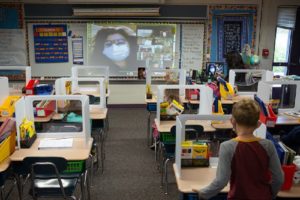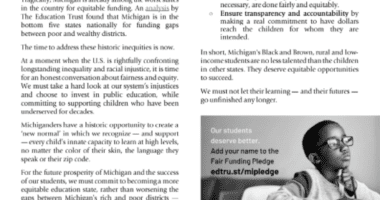Amid COVID-19, millions of students may have stopped attending school
Interrupted learning may have dire consequences for student learning, especially for the most underserved students.
When schools closed in March amid the COVID-19 pandemic, some school districts across the nation quickly pivoted to distance learning and instruction. Yet other districts struggled not only to provide the resources for students to learn remotely, but had difficulty even locating their students — especially those who are the most vulnerable — and reconnecting them to school.
Today, that leaves a troubling unanswered question in Michigan and across the nation: how many students are still missing from school?
On Nov. 15, Governor Whitmer and Michigan Department of Health and Human Services Director Robert Gordon announced new COVID-19 restrictions as positive cases continue to increase drastically in Michigan, including shuttering in-person instruction in high schools and colleges, with the goal of saving lives.
And yet, the phenomenon of interrupted learning may have a devastating impact for millions of students across the nation. According to a Bellwether Education Partners analysis, as many as 3 million students nationally may have stopped attending schools due to abrupt – and now intermittent – closures, as well as the uneven access to instruction that followed. This is a massive number of children who may suffer long-term consequences such as a decline in academic achievement or lifetime wages.

Second-grade students sit behind protection shields at socially distanced desks.
Photo by Allison Shelley for American Education: Images of Teachers and Students in Action
Interrupted learning is expected to exacerbate longstanding opportunity and achievement gaps for the most underserved students, including Black, Latino and low-income students. According to a report by McKinsey & Company, school closures may result in Black students falling behind by 10.3 months, Hispanic students by 9.2 months, and low-income students by more than a year. The analysis suggested that existing achievement gaps could grow by 15 to 20 percent.
The reasons for the anticipated growth in gaps are varied, including lack of access to reliable wi-fi, limited digital devices for all the students in the family, lack of access to a suitable place for learning and other barriers. For instance, an analysis by the Education Trust-Midwest showed that in communities across the state, access to devices and reliable broadband vary greatly, disproportionately affecting students of color, students from low-income backgrounds and students in rural communities.
This uneven digital access also builds upon the challenges and inequities millions of American children already faced in accessing online resources to complete homework assignments, improving digital literacy skills and continuing or accelerating their learning at home.
And with the educational status of millions of students simply unknown, the impact may be far more devastating.
Detroit Public Schools Community District last month reported that enrollment was down by 3,000 students, leading Superintendent Dr. Nikolai Vitti to share his concerns over chronic absenteeism, the potential impact on student achievement and parents’ ability to support learning at home. Districts like Flint Community Schools and Kalamazoo Public Schools also reported troubling enrollment declines.
At the time, Vitti was urging more face-to-face instruction; however, rising COVID cases recently forced the district to announce a new system-wide closure — even before the Governor’s announcement this past weekend.
School districts across the state are facing similar decisions, while still facing enormous pressure to meet students’ varied needs. And yet the disparities remain, with some wealthier districts having more resources, capacity and technological infrastructure to respond.
“The COVID-19 pandemic continues to magnify the profound differences between what affluent districts can offer their students compared to chronically under-resourced districts,” said Amber Arellano, executive director of the Education Trust-Midwest.
In March, the Education Trust-Midwest called on leaders to enact a Marshall Plan for public education to respond to the crisis an address longstanding inequities.
Eight months into the pandemic that shows no signs of slowing, it’s critical for the federal government, state, school districts, and community organizations to redouble efforts and join together to find students who have gone missing from school, ensure they re-engage in learning and provide the supports to help them achieve, Arellano said.
“We must act with great urgency to find and support every student that has become disconnected from school to ensure that our most underserved students do not fall further behind,” Arellano said. “This will require all forces coming together for the safety of our state’s schoolchildren – and their future success.”
To best support school districts in allocating local, state, and federal resources to ensure all students have access to high-quality learning, we continue to urge states to take the following actions:
- Create and maintain centralized, clear, and regular communication and real-time data reporting to community stakeholders.
- Maintain and strengthen critical supports for students and families in need.
- Provide guidance and resources to districts on educational services for vulnerable populations.
- Support districts to develop plans with short- and long-term solutions to address COVID-19 challenges.
- Ensure underserved student groups, including low-income students, English learners, and students with disabilities, are prioritized in budget decisions.



